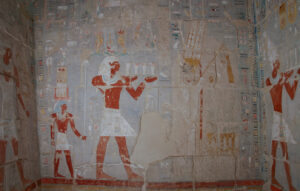The northern and southern chambers of Amun on the upper terrace of the Temple of Hatshepsut (c.1473-1458 BC) in Deir el-Bahri, opposite the city of Luxor, and the tomb of Meru in the North Asasif cemetery, were opened on Thursday.
Mostafa Waziri, Secretary General of the Supreme Council of Antiquities, said that the southern chamber was probably used to store aromatic materials and linen used during religious rituals. While the walls of the northern chamber, whose use is not yet known, depicted scenes of offerings to the god Amun-Ra by Queen Hatshepsut and her patron, King Thutmose III and some of the ritual actions they performed such as running with the oar.
Anna Wodzińska, Director of the Research Centre in Cairo Polish Centre of Mediterranean Archaeology, said that behind the doors of both chambers, there is a scene depicting the architect Senenmut, the most prominent of the court men of Queen Hatshepsut. She noted that pictures of Senenmut inside these two chambers only appear while he is standing instead from a kneeling position, which might suggest a special function for these two chambers.
Fathy Yassin, Director General of Antiquities in Upper Egypt, said that the tomb of Meru, the ancient Egyptian official under king Mentuhotep II of the 11th Dynasty, is carved into a rocky cliff called North Asasif, which is a continuation of the rocky amphitheatre at Deir el-Bahri and most prominent officials in Egypt from the Middle Kingdom era (2055-1773) BC were buried.
This tomb is the first archaeological site from this early period on the western mainland of Luxor to be made available to visitors.
Meru’s tomb consists of a façade and a corridor leading to an offering compartment with a niche for placing the statue of the deceased. There is also a burial well, at the end of which there is a burial chamber with a coffin.
Thursday’s event was witnessed by famous archaeologist Zahi Hawas. It came within the keenness of the Ministry of Tourism and Antiquities, represented by the Supreme Council of Antiquities, to restore, maintain and preserve archaeological sites in their various historical eras.










Discussion about this post